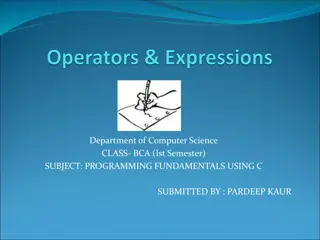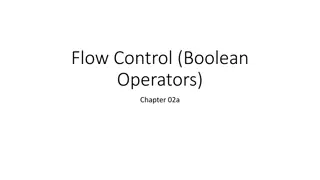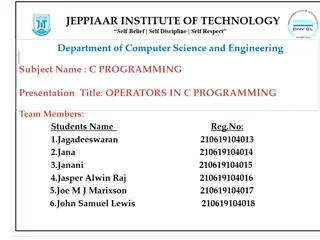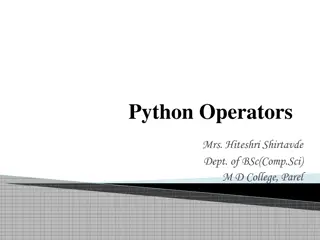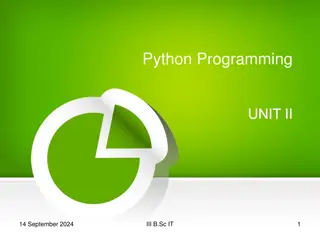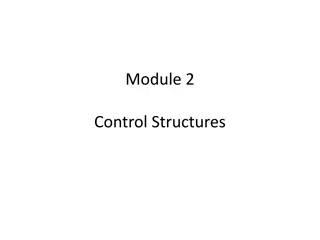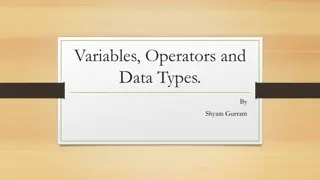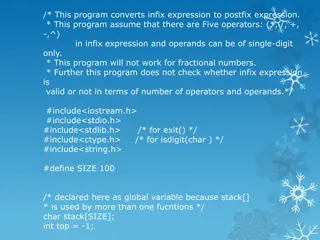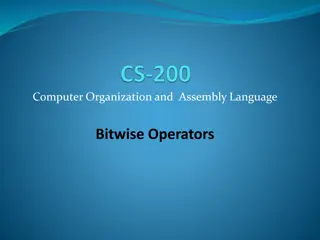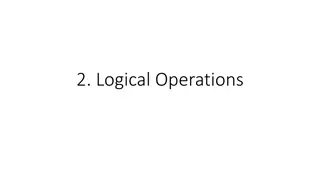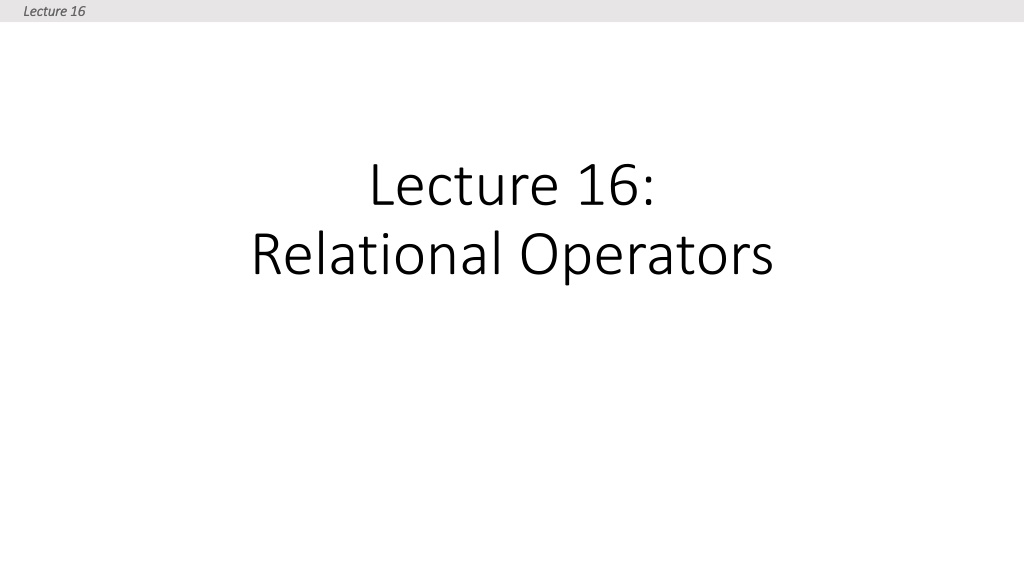
Understanding Relational Database Operators in CS Lectures
Dive into the world of relational database operators with topics such as logical vs. physical operators, query execution, architecture of DBMS, and how to optimize database queries effectively.
Download Presentation

Please find below an Image/Link to download the presentation.
The content on the website is provided AS IS for your information and personal use only. It may not be sold, licensed, or shared on other websites without obtaining consent from the author. If you encounter any issues during the download, it is possible that the publisher has removed the file from their server.
You are allowed to download the files provided on this website for personal or commercial use, subject to the condition that they are used lawfully. All files are the property of their respective owners.
The content on the website is provided AS IS for your information and personal use only. It may not be sold, licensed, or shared on other websites without obtaining consent from the author.
E N D
Presentation Transcript
Lecture 16 Lecture 16 Lecture 16: Relational Operators
Lecture 16 Lecture 16 Announcements 1. Should I attend grad school? Do I have the right profile? 2. But SnapBook (the hottest tech giant) is giving me 150k 3. Why is CS the right choice? 2
Graduate School Information Panel Thursday, Nov 9 @ 3:00PM 1240CS Should I attend graduate school in CS? How do I choose the right graduate program? How do I prepare a competitive application? Join us for a live Q&A with CS faculty, graduate students, and a graduate school admissions coordinator!
Lecture 16 Lecture 16 Lecture 16: Relational Operators
Lecture 16 Lecture 16 Today s Lecture 1. Logical vs Physical Operators 2. Select, Project 3. Prelims on Joins 5
Lecture 16 Lecture 16 1. Logical vs Physical Operators 6
Lecture 16 Lecture 16 What you will learn about in this section 1. Recap: DB queries 2. Logical Plan 3. Physical Plan 7
Lecture 16 Lecture 16 Architecture of a DBMS query Query Execution data access Storage Manager I/O access
Lecture 16 Lecture 16 Logical vs Physical Operators Logical operators what they do e.g., union, selection, project, join, grouping Physical operators how they do it e.g., nested loop join, sort-merge join, hash join, index join
Lecture 16 Lecture 16 Example SELECT P.buyer FROM Purchase P, Person Q WHERE P.buyer=Q.name AND Q.city= Madison Assume that Person has a B+ tree index on city
Lecture 16 Lecture 16 Example: Logical Plan PROJECT on buyer SELECT P.buyer FROM Purchase P, Person Q JOIN buyer = name WHERE P.buyer=Q.name AND Q.city= Madison SELECT city = Madison SELECT Purchase Person
Lecture 16 Lecture 16 Example: Physical Plan Hash-based Project SELECT P.buyer FROM Purchase P, Person Q WHERE P.buyer=Q.name Nested Loop Join AND Q.city= Madison Table Scan Index Scan Purchase Person
Lecture 16 Lecture 16 Relational Operators We will see implementations for the following relational operators: select project join aggregation set operators
Lecture 16 Lecture 16 2. Selection and Projection 14
Lecture 16 Lecture 16 What you will learn about in this section 1. Selection 2. Projection 15
Lecture 16 Lecture 16 Select Operator access path = way to retrieve tuples from a table File Scan scan the entire file I/O cost: O(N), where N = #pages Index Scan: use an index available on some predicate I/O cost: it varies depending on the index
Lecture 16 Lecture 16 Index Scan Cost I/O cost for index scan Hash index: O(1) but we can only use it with equality predicates B+ tree index: O(logFN) + X X depends on whether the index is clustered or not: unclustered: X = # selected tuples clustered: X = (#selected tuples)/ (#tuples per page)
Lecture 16 Lecture 16 B+ Tree Scan Example Example A relation with 1M records 100 records on a page 500 (key, rid) pairs on a page 1% Selectivity 10% Selectivity clustered 3+100 3+1000 unclustered 3+10,000 3+100,000 unclustered + sorting 3+(~10,000) 3+(~10,000)
Lecture 16 Lecture 16 General Selection Condition So far we studied selection on a single attribute How do we use indexes when we have multiple selection conditions? R.a = 10 AND R.b > 10 R.a = 10 OR R.b < 20
Lecture 16 Lecture 16 Index Matching We say that an index matches a selection predicate if the index can be used to evaluate it Consider a conjunction-only selection. An index matches (part of) a predicate if Hash: only equality operation & the predicate includes all index attributes B+ Tree: the attributes are a prefix of the search key (any ops are possible)
Lecture 16 Lecture 16 Example A relation R(a,b,c,d) Does the index match the predicate? Predicate B+ tree on (a,b,c) Hash index on (a,b,c) a=5 AND b=3 yes no a>5 AND b<4 yes no b=3 no no a=5 AND c>10 yes no a=5 AND b=3 AND c=1 yes yes a=5 AND b=3 AND c=1 AND d >6 yes yes a=5 and b=3 and c=1 are primary conjuncts here
Lecture 16 Lecture 16 Index Matching A predicate can match more than one index Example: hash index on (a) and B+ tree index on (b, c) predicate: a=7 AND b=5 AND c=4 which index should we use? 1. use either index 2. use both indexes, then intersect the rid sets, and then fetch the tuples
Lecture 16 Lecture 16 Choosing the Right Index Selectivity of an access path = fraction of data pages that need to be retrieved We want to choose the most selective path! Estimating the selectivity of an access path is a hard problem
Lecture 16 Lecture 16 Estimating Selectivity Predicate: a=3 AND b=4 AND c=5 hash index on (a,b,c) selectivity is approximated by #pages / #keys #keys is known from the index hash index on (b) multiply the reduction factors for each primary conjunct reduction factor = #pages/#keys if #keys is unknown, use 1/10 as default value this assumes independence of the attributes!
Lecture 16 Lecture 16 Estimating Selectivity Predicate: a > 10 AND a < 60 If we have a range condition, we assume that the values are uniformly distributed ???????? ??? ??? The selectivity will be approximated by
Lecture 16 Lecture 16 Predicates and Disjunction hash index on (a) + hash index on (b) a=7 or b>5 a file scan is required hash index on (a) + B+ tree on (b) a=7 or b>5 scan or use both indexes (fetch rids and take the union) hash index on (a) + B+ tree on (b) (a=7 or c>5) and b > 5 we can use the B+ tree
Lecture 16 Lecture 16 Projection Simple case: SELECT R.a, R.d scan the file and for each tuple output R.a, R.d Hard case: SELECT DISTINCT R.a, R.d project out the attributes eliminate duplicate tuples (this is the difficult part!)
Lecture 16 Lecture 16 Projection: Sort-based Na ve algorithm: 1. scan the relation and project out the attributes 2. sort the resulting set of tuples using all attributes 3. scan the sorted set by comparing only adjacent tuples and discard duplicates
Lecture 16 Lecture 16 Example R(a, b, c, d, e) M = 1000 pages B = 20 buffer pages Each field in the tuple has the same size Suppose we want to project on attribute a
Lecture 16 Lecture 16 Sort-based Cost Analysis initial scan = 1000 I/Os after projection T =(1/5)*1000 = 200 pages cost of writing T = 200 l/Os sorting in 2 passes = 2 * 2 * 200 = 800 l/Os final scan = 200 I/Os total cost = 2200 I/Os
Lecture 16 Lecture 16 Projection: Sort-based We can improve upon the na ve algorithm by modifying the sorting algorithm: 1. In Pass 0 of sorting, project out the attributes 2. In subsequent passes, eliminate the duplicates while merging the runs
Lecture 16 Lecture 16 Sort-based Cost Analysis we can sort in 2 passes first pass costs 1000 + 200 = 1200 I/Os the second pass costs 200 I/Os (not counting writing the result to disk) total cost = 1400 I/Os
Lecture 16 Lecture 16 Projection: Hash-based 2-phase algorithm: partitioning project out attributes and split the input into B-1 partitions using a hash function h duplicate elimination read each partition into memory and use an in-memory hash table (with a different hash function) to remove duplicates
Lecture 16 Lecture 16 Projection: Hash-based When does the hash table fit in memory? size of a partition = ? / (? 1), where T is #pages after projection size of hash table = ? ? / (? 1), where is a fudge factor (typically ~ 1.2) So, it must be ? > ? ? / (? 1), or approximately ? > ? ?
Lecture 16 Lecture 16 Hash-based Cost Analysis T = 200 so the hash table fits in memory! partitioning cost = 1000 + 200 = 1200 I/Os duplicate elimination cost = 200 I/Os total cost = 1400 I/Os
Lecture 16 Lecture 16 Comparison Benefits of sort-based approach better handling of skew the result is sorted The I/O costs are the same if B2 > T 2 passes are needed by both algorithms
Lecture 16 Lecture 16 Projection: Index-based Index-only scan projection attributes subset of index attributes apply projection algorithm only to data entries If an orderedindex contains all projection attributes as prefix of search key: retrieve index data entries in order discard unwanted fields compare adjacent entries to eliminate duplicates 1. 2. 3.
Lecture 16 Lecture 16 3. Joins 38
Lecture 16 Lecture 16 What you will learn about in this section 1. RECAP: Joins 2. Nested Loop Join (NLJ) 3. Block Nested Loop Join (BNLJ) 4. Index Nested Loop Join (INLJ) 39
Lecture 16 Lecture 16 1. Nested Loop Joins 40
Lecture 16 Lecture 16 What you will learn about in this section 1. RECAP: Joins 2. Nested Loop Join (NLJ) 3. Block Nested Loop Join (BNLJ) 4. Index Nested Loop Join (INLJ) 41
Lecture 16 > Joins Lecture 16 > Joins RECAP: Joins
Lecture 16 > Joins Lecture 16 > Joins Joins: Example SELECT R.A,B,C,D FROM R, S WHERE R.A = S.A Example: Returns all pairs of tuples r ?,? ? such that ?.? = ?.? ? ? R S A B C A D A B C D 1 0 1 3 7 2 3 4 2 2 3 4 2 2 2 5 2 2 3 3 1 1 43
Lecture 16 > Joins Lecture 16 > Joins Joins: Example SELECT R.A,B,C,D FROM R, S WHERE R.A = S.A Example: Returns all pairs of tuples r ?,? ? such that ?.? = ?.? ? ? R S A B C A D A B C D 1 0 1 3 7 2 3 4 2 2 3 4 2 2 2 3 4 3 2 5 2 2 3 3 1 1 44
Lecture 16 > Joins Lecture 16 > Joins Joins: Example SELECT R.A,B,C,D FROM R, S WHERE R.A = S.A Example: Returns all pairs of tuples r ?,? ? such that ?.? = ?.? ? ? R S A B C A D A B C D 1 0 1 3 7 2 3 4 2 2 3 4 2 2 2 3 4 3 2 5 2 2 3 2 5 2 2 3 1 1 45
Lecture 16 > Joins Lecture 16 > Joins Joins: Example SELECT R.A,B,C,D FROM R, S WHERE R.A = S.A Example: Returns all pairs of tuples r ?,? ? such that ?.? = ?.? ? ? R S A B C A D A B C D 1 0 1 3 7 2 3 4 2 2 3 4 2 2 2 3 4 3 2 5 2 2 3 2 5 2 2 3 1 1 2 5 2 3 46
Lecture 16 > Joins Lecture 16 > Joins Joins: Example SELECT R.A,B,C,D FROM R, S WHERE R.A = S.A Example: Returns all pairs of tuples r ?,? ? such that ?.? = ?.? ? ? R S A B C A D A B C D 1 0 1 3 7 2 3 4 2 2 3 4 2 2 2 3 4 3 2 5 2 2 3 2 5 2 2 3 1 1 2 5 2 3 3 1 1 7 47
Lecture 16 > Joins Lecture 16 > Joins Semantically: A Subset of the Cross Product SELECT R.A,B,C,D FROM R, S WHERE R.A = S.A Example: Returns all pairs of tuples r ?,? ? such that ?.? = ?.? ? ? R S A B C D A B C A D 2 3 4 2 1 0 1 3 7 Can we actually implement a join in this way? 2 3 4 3 2 3 4 2 2 2 5 2 2 2 5 2 2 3 Cross Product Filter by conditions (r.A = s.A) 2 5 2 3 3 1 1 3 1 1 7 48
Lecture 16 > Joins Lecture 16 > Joins Notes We write ? ?to mean join R and S by returning all tuple pairs where all shared attributes are equal We write ? ? on Ato mean join R and S by returning all tuple pairs where attribute(s) A are equal For simplicity, we ll consider joins on two tables and with equality constraints ( equijoins ) However joins can merge > 2 tables, and some algorithms do support non- equality constraints!
Lecture 16 > NLJ Lecture 16 > NLJ Nested Loop Joins 50



